Just as a frame transforms a masterpiece, the right border plants can elevate your garden from ordinary to extraordinary. You’ll find that defining your outdoor space isn’t just about creating boundaries; it’s about crafting living transitions that enhance your landscape’s overall design. Whether you’re working with a sunny cottage garden or a shaded woodland retreat, these ten carefully selected border plants will help you create distinct spaces while adding texture, color, and year-round interest to your garden’s edges.
Contents
- 1 Lavender: A Classic Border Choice
- 2 Boxwood for Formal Garden Edges
- 3 Ornamental Grasses as Living Boundaries
- 4 Creeping Thyme for Ground-Level Definition
- 5 Dwarf Barberry: Color and Structure Combined
- 6 Russian Sage for Dramatic Border Impact
- 7 Japanese Forest Grass in Shaded Borders
- 8 Sedums: Low-Maintenance Border Solutions
- 9 Dwarf Hydrangeas for Statement Borders
- 10 Sweet Alyssum for Delicate Edge Definition
Lavender: A Classic Border Choice
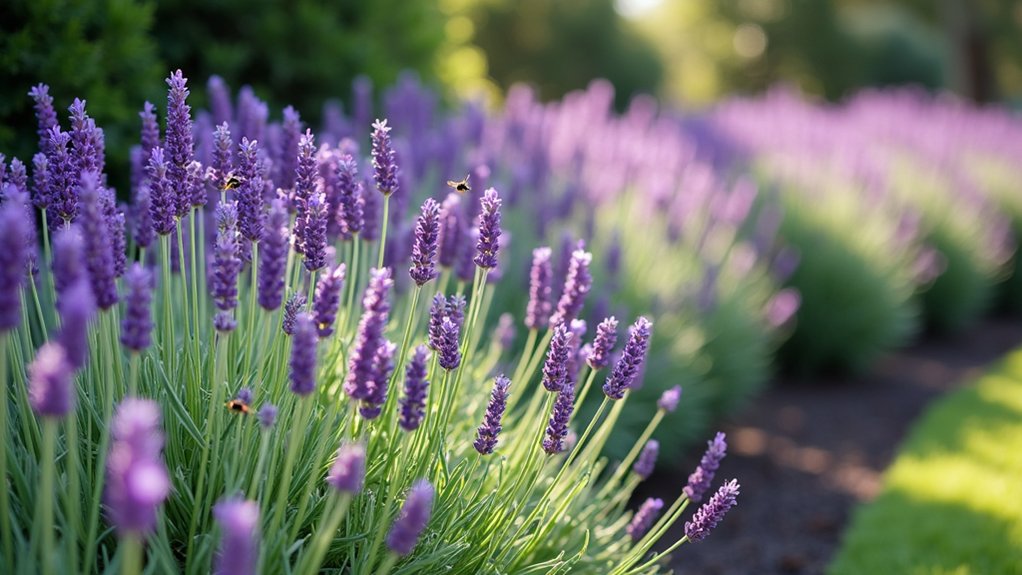
Lavender makes a stunning border plant with its silvery-green foliage and iconic purple flower spikes that rise above compact, mounded forms. This aromatic Mediterranean herb creates a soft, elegant edge while attracting pollinators and providing year-round structure to garden designs.
The plants typically grow 2-3 feet tall and wide, offering both visual impact and a delightful fragrance that intensifies when brushed against or on warm days.
- Light: Full sun (6-8 hours daily)
- Soil: Well-draining, slightly alkaline soil
- Water: Drought-tolerant once established; minimal watering needed
- Spacing: 18-24 inches between plants
- Hardiness: Zones 5-9, depending on variety
- pH: 6.7-7.3
- Drainage: Excellent drainage required; can’t tolerate wet feet
Regular pruning is essential for maintaining healthy lavender borders. Cut back plants by one-third in early spring to promote bushy growth, and deadhead spent blooms throughout the growing season to encourage repeated flowering.
After the final bloom of the season, trim plants into neat mounds to prevent them from becoming woody and splitting open in the center. Avoid fertilizing lavender, as rich soil leads to excessive foliage growth at the expense of flowers, and ensure good air circulation between plants to prevent fungal issues.
Boxwood for Formal Garden Edges
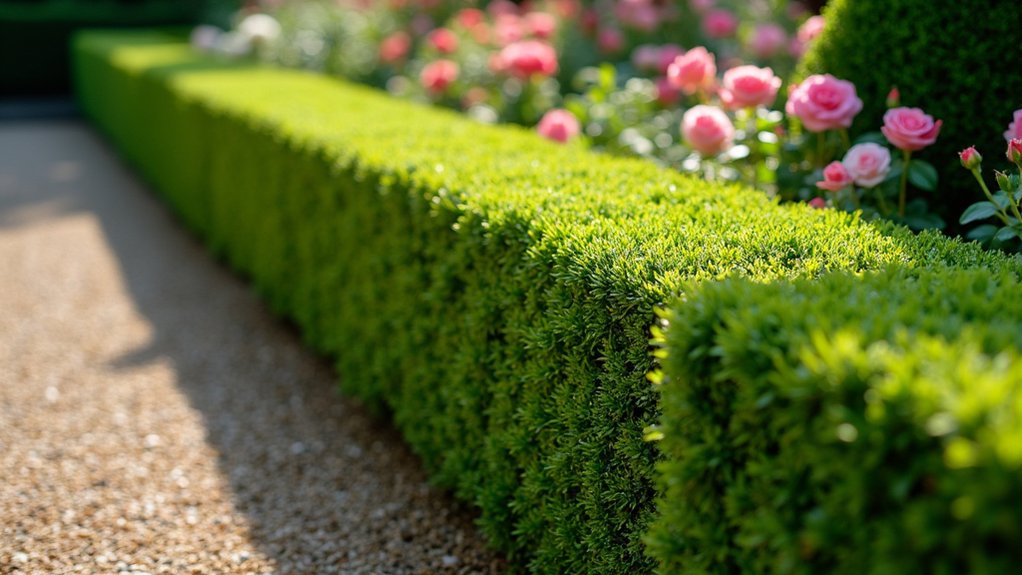
Boxwood (Buxus) stands as a classic choice for formal garden borders, characterized by its dense, evergreen foliage and clean-lined appearance. These versatile shrubs can be meticulously shaped into crisp hedges, geometric forms, or left naturally rounded, making them perfect for creating definition and structure in garden designs.
Their small, glossy leaves and compact growth pattern provide year-round visual interest and a sophisticated framework for other plantings.
- Light: Partial to full sun; can tolerate shade but may grow slower
- Soil: Well-draining, slightly acidic to neutral pH (6.5-7.5)
- Water: Regular watering until established; moderate thereafter
- Temperature: Hardy in zones 5-9
- Spacing: 2-3 feet apart for hedges
- Fertilizer: Light feeding in spring with balanced, slow-release fertilizer
- Height: Typically 3-6 feet, depending on variety
Regular maintenance is crucial for keeping boxwood borders looking their best.
Prune twice yearly – once in late spring after new growth appears and again in late summer – to maintain desired shape and prevent woody interiors.
Monitor for boxwood blight and leaf miners, particularly in humid conditions, and improve air circulation by thinning interior branches.
Remove fallen leaves and debris from the base of plants to prevent disease, and apply a layer of mulch while keeping it away from the trunk to retain moisture and suppress weeds.
Ornamental Grasses as Living Boundaries
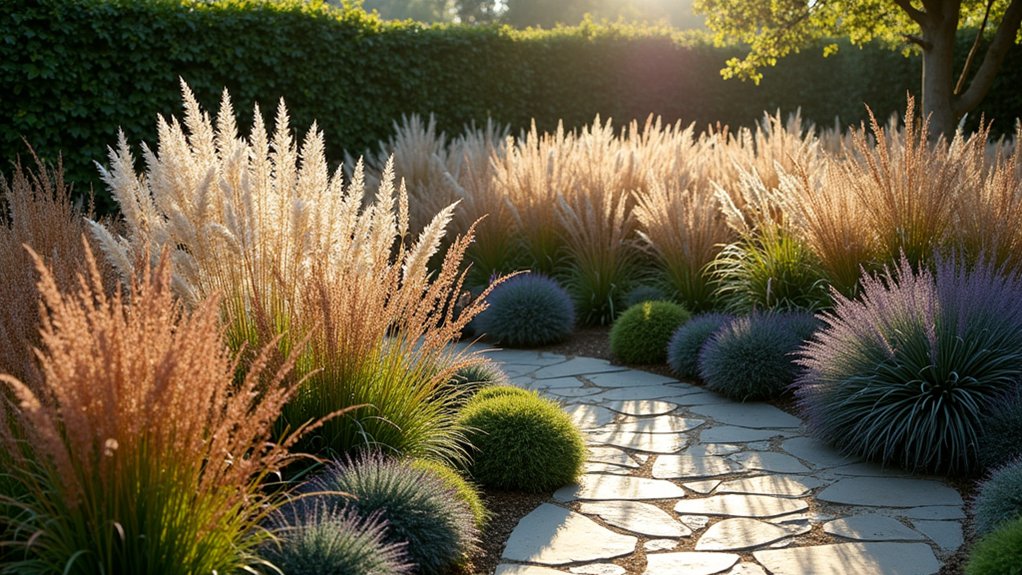
Ornamental grasses create dynamic, living boundaries that add movement, texture, and year-round interest to garden borders.
These versatile plants range from compact varieties reaching just 1-2 feet to towering specimens up to 8 feet tall, featuring graceful arching forms and distinctive seed heads. Many ornamental grasses display seasonal color changes, transitioning from green to gold, burgundy, or bronze in autumn, while their plumes and seed heads provide winter interest and natural food sources for birds.
Growing Conditions:
- Full sun to partial shade, with most varieties preferring 6+ hours of direct sunlight
- Well-draining soil with moderate fertility
- Drought tolerant once established, though regular watering during establishment
- Soil pH between 5.5 and 7.5
- Space plants according to mature width, typically 2-4 feet apart
- Hardy in zones 4-9, depending on variety
Maintaining ornamental grasses requires minimal effort throughout the growing season.
Cut back deciduous varieties to 4-6 inches above ground level in late winter or early spring before new growth emerges. Remove dead foliage from evergreen varieties by combing through with gloved hands.
Division is necessary every 3-4 years when centers become woody or die out, ideally performed in spring for warm-season grasses and fall for cool-season varieties.
Avoid fertilizing established ornamental grasses, as excess nutrients can lead to floppy growth and reduced winter hardiness.
Creeping Thyme for Ground-Level Definition
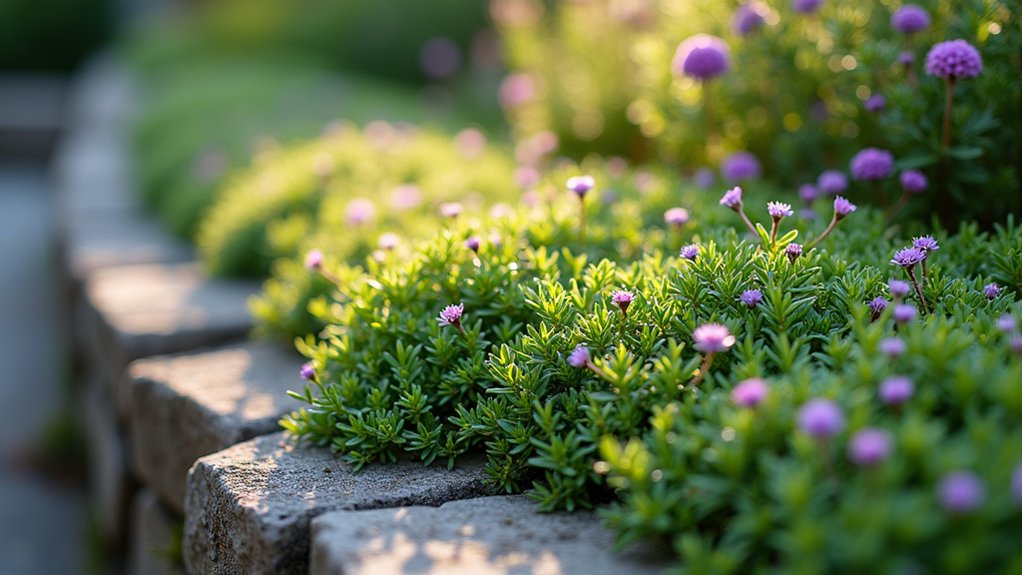
Creeping Thyme (Thymus serpyllum) creates a dense, low-growing carpet of tiny, aromatic leaves punctuated by delicate purple, pink, or white flowers in summer. This versatile ground cover reaches only 2-4 inches in height but spreads 12-18 inches wide, making it perfect for defining garden borders while suppressing weeds.
The plant’s spreading habit allows it to cascade over walls or fill gaps between stepping stones, while its fragrant foliage releases a pleasant herbal scent when brushed against or walked upon.
- Full sun to partial shade, with best flowering in full sun
- Drought-tolerant once established
- Well-draining, sandy or rocky soil
- pH range of 6.0-8.0
- Low to moderate water needs
- Hardy in USDA zones 4-9
- Tolerates light foot traffic
To maintain healthy creeping thyme, trim back spent flowers and overgrown areas in late summer to prevent woody growth and maintain its compact form.
Spring pruning of dead foliage encourages fresh growth and helps prevent center die-out. While the plant rarely needs fertilizer, applying a light layer of compost in spring can promote vigorous growth.
Remove any weeds that emerge promptly to prevent competition, and avoid overwatering, which can lead to root rot in this Mediterranean native.
Dwarf Barberry: Color and Structure Combined
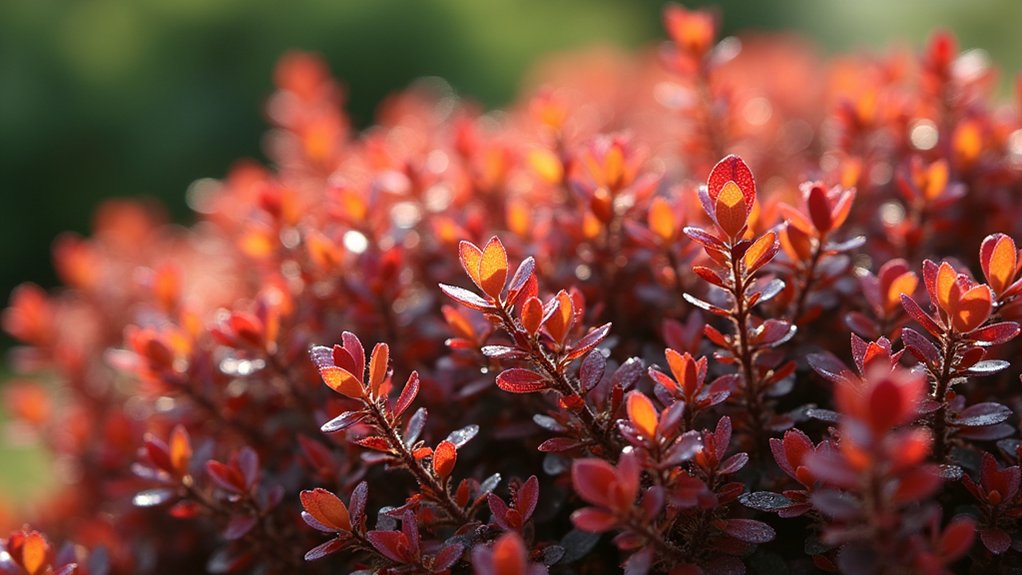
Dwarf Barberry (Berberis thunbergii) is a compact, ornamental shrub that adds year-round visual interest to garden borders. Growing only 2-3 feet tall and wide, this versatile plant features dense, thorny branches adorned with small, rounded leaves that transform from vibrant burgundy, purple, or golden hues in spring and summer to brilliant orange-red in fall.
The thorny nature of the plant makes it an excellent barrier hedge while still maintaining an attractive appearance with its naturally mounded shape.
- Light: Full sun to partial shade; best color development in full sun
- Soil: Well-draining, slightly acidic to neutral pH (5.5-7.0)
- Water: Moderate; drought-tolerant once established
- Hardiness: USDA zones 4-8
- Spacing: 2-3 feet apart
- Growth Rate: Slow to moderate
Regular pruning in late winter or early spring helps maintain the dwarf barberry‘s compact shape and promotes denser growth.
Remove any dead, damaged, or crossing branches to improve air circulation and prevent disease. While the plant is generally low-maintenance, applying a layer of mulch around the base helps retain moisture and suppress weeds.
Fertilization is typically unnecessary unless soil is poor, in which case a slow-release, balanced fertilizer can be applied in spring.
Russian Sage for Dramatic Border Impact
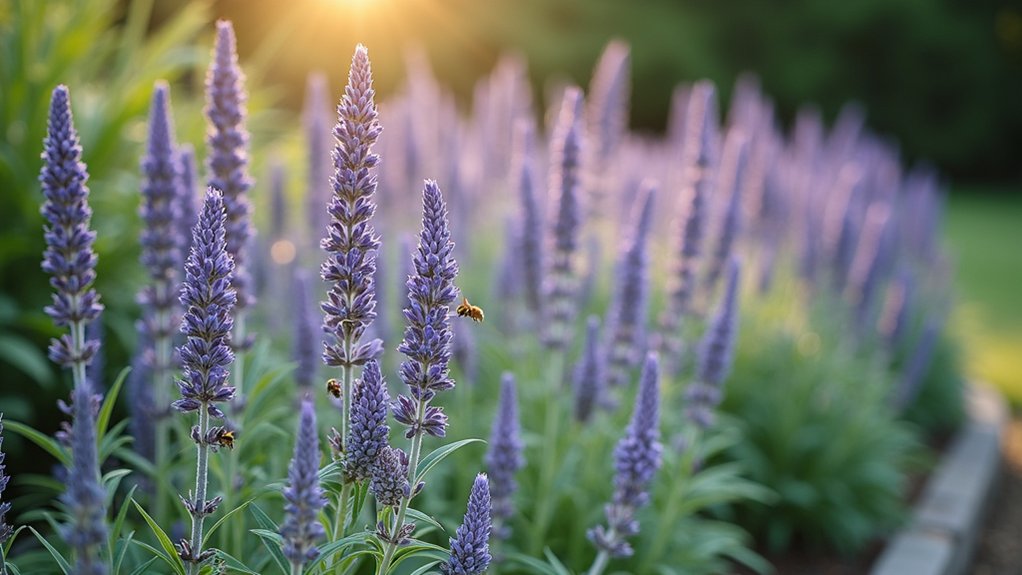
Russian Sage (Perovskia atriplicifolia) creates a striking border presence with its tall, upright stems adorned with silvery-gray foliage and abundant lavender-blue flower spikes that bloom from midsummer through fall. This drought-tolerant perennial grows in a bushy, architectural form reaching 3-5 feet tall, creating a dramatic, airy effect that adds both height and texture to garden borders while attracting pollinators with its aromatic foliage and blossoms.
- Full sun exposure required for optimal growth and flowering
- Well-draining soil is essential; tolerates poor, rocky soils
- Drought tolerant once established; water sparingly
- Prefers alkaline to neutral pH levels
- Hardy in USDA zones 4-9
- Space plants 24-36 inches apart to allow for mature spread
Regular pruning is key to maintaining Russian Sage’s shape and vigor. Cut back stems to about 6 inches above ground level in late winter or early spring before new growth emerges.
During the growing season, trim leggy stems and remove spent flower spikes to encourage a second flush of blooms. While the plant may flop in rich soils or shade, supporting it with stakes or planting it among sturdy companions can help maintain its upright form.
Japanese Forest Grass in Shaded Borders
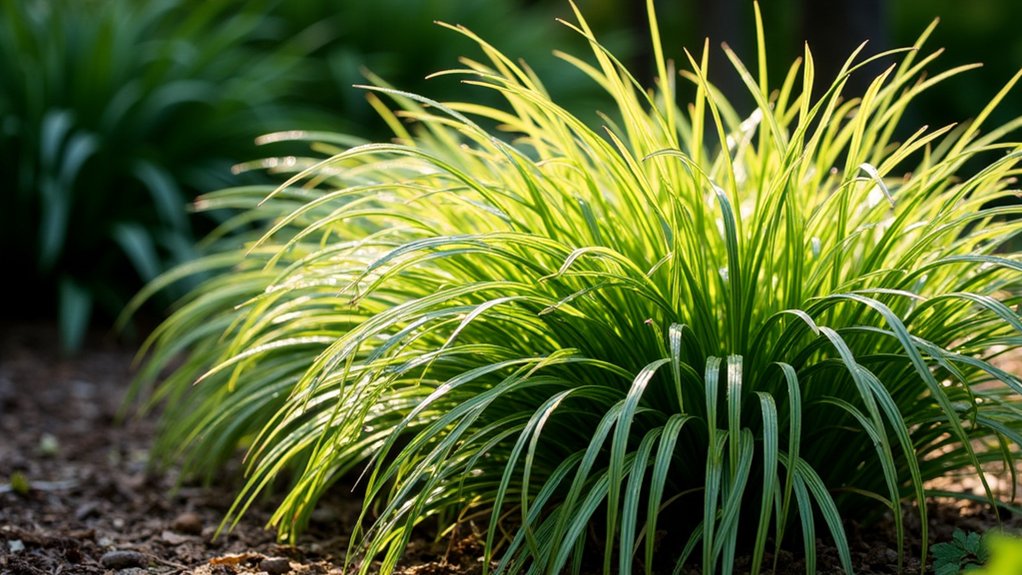
Japanese Forest Grass (Hakonechloa macra) is an elegant ornamental grass that creates a stunning cascading effect in shaded border gardens. This graceful perennial forms neat mounds of arching, bamboo-like foliage that reaches 12-18 inches in height. The slender leaves move with the slightest breeze, adding dynamic movement to shaded areas.
Available in various cultivars, including the popular ‘Aureola’ with its striking gold-striped leaves, Japanese Forest Grass provides visual interest from spring through winter when its foliage turns copper-bronze.
Growing Conditions:
- Light: Partial to full shade; morning sun tolerated
- Soil: Rich, well-draining, consistently moist soil
- pH: 5.5-7.0
- Temperature: Hardy in zones 5-9
- Spacing: 18-24 inches apart
- Water: Regular watering, keeping soil consistently moist
- Humidity: Moderate to high
Maintaining Japanese Forest Grass requires minimal effort once established, but attention to certain details ensures optimal growth.
Cut back old foliage in late winter or early spring before new growth emerges, and remove any dead leaves throughout the growing season.
Apply a layer of organic mulch around plants to retain moisture and suppress weeds, being careful not to pile mulch against the crown.
Division every 3-4 years in spring helps rejuvenate the plant and maintain its compact growth habit, while also providing opportunities for propagation.
Sedums: Low-Maintenance Border Solutions
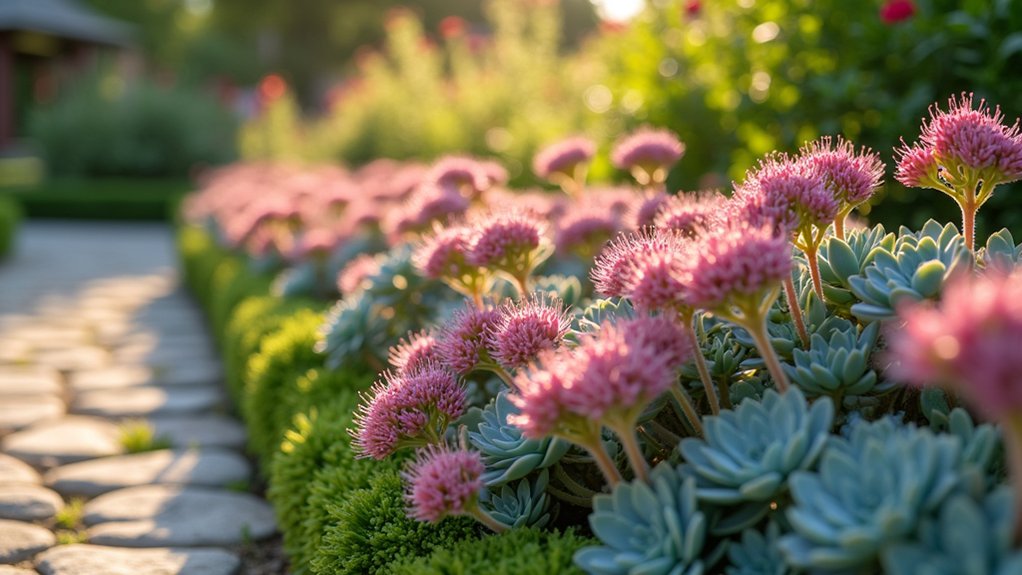
Sedums, also known as stonecrop, are excellent low-maintenance border plants that offer year-round interest with their fleshy, succulent leaves and clusters of tiny star-shaped flowers.
These versatile perennials range from low-growing groundcovers to upright varieties reaching 2 feet tall, producing blooms in shades of pink, red, yellow, or white from late summer through fall. Their thick leaves store water efficiently, making them drought-tolerant, while their sturdy stems maintain an attractive presence even in winter.
Growing Conditions:
- Full sun to partial shade, with best flowering in full sun
- Well-draining soil; can tolerate poor soil conditions
- Minimal watering once established; drought-tolerant
- USDA hardiness zones 3-10 (variety dependent)
- pH tolerance range of 6.0-7.5
- Spacing 12-18 inches apart, depending on variety
Maintaining healthy sedums requires minimal effort, but certain practices ensure optimal growth.
Remove spent flower heads in late fall or early spring to maintain neat appearance, though leaving them intact provides winter interest and food for birds.
Division every 3-4 years prevents center die-out in mature plants and reinvigorates growth.
Avoid overwatering and fertilizing, as this can cause stems to become leggy and flop over; instead, trim back tall varieties by one-third in late spring to promote bushier growth and stronger stems.
Dwarf Hydrangeas for Statement Borders
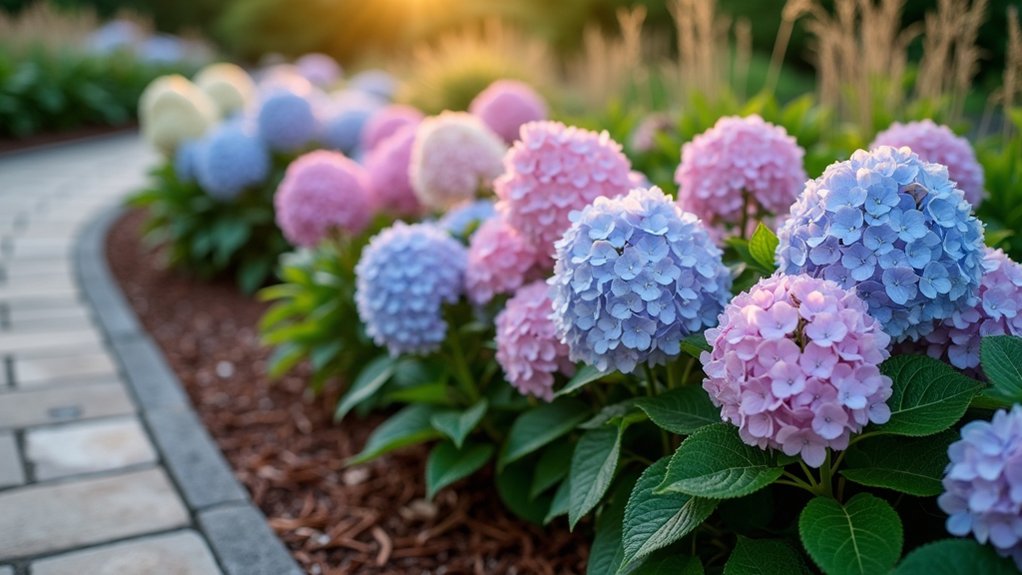
Dwarf hydrangeas offer the same stunning blooms as their full-sized cousins but in a compact form perfect for garden borders. These smaller varieties typically grow 2-4 feet tall and wide, producing large, showy flower heads in blues, pinks, or whites, depending on soil pH. Popular cultivars like ‘Little Lime,’ ‘Tiny Tuff Stuff,’ and ‘Bobo’ create dramatic visual impact while maintaining a manageable size that won’t overwhelm border spaces.
- Light: Partial shade to full sun, with protection from intense afternoon sun
- Soil: Rich, well-draining, acidic to neutral soil (pH 5.5-6.5)
- Water: Consistent moisture; about 1 inch per week
- Temperature: Hardy in USDA zones 5-9
- Spacing: Plant 3-4 feet apart
- Fertilizer: Light feeding with balanced fertilizer in spring
- Drainage: Must have good drainage to prevent root rot
Regular deadheading spent blooms encourages continued flowering and maintains a tidy appearance.
Prune in late winter or early spring, removing dead or crossing branches and shaping as needed. For reblooming varieties, a second light pruning after the first flush of flowers can promote additional blooming.
Apply a thick layer of mulch around the base to retain moisture and suppress weeds, but keep it away from the stems to prevent rot. During extended dry periods, deep watering at the root zone helps establish strong root systems.
Sweet Alyssum for Delicate Edge Definition
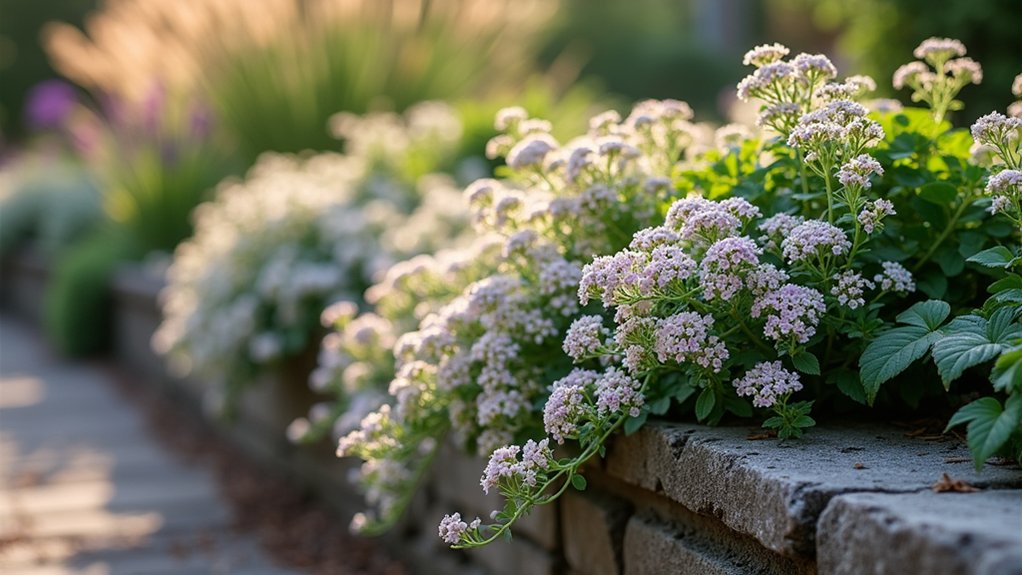
Sweet Alyssum creates a charming, low-growing carpet of tiny white, pink, or purple flowers that cascade gracefully along garden borders. This delicate annual plant typically reaches only 4-6 inches in height but spreads 6-12 inches wide, forming dense mats of fragrant blooms above small, narrow green leaves.
The honey-scented flowers attract beneficial pollinators while providing continuous blooming from spring through fall, making it an excellent choice for softening hard edges and filling gaps between larger border plants.
- Light: Full sun to partial shade; performs best with morning sun and afternoon shade in hot climates
- Water: Keep soil consistently moist but not waterlogged; water deeply when top inch of soil feels dry
- Soil: Well-draining, moderately fertile soil with pH 6.0-7.0
- Temperature: Thrives in temperatures between 60-70°F
- Spacing: Plant 6-8 inches apart to allow for spread
- Hardiness: USDA zones 5-9, grown as annual in most regions
Regular deadheading of spent blooms encourages continuous flowering and prevents self-seeding, though allowing some seeds to drop can lead to natural reseeding for the following season.
Trim back leggy growth by about one-third during mid-summer to rejuvenate plants and maintain compact form. During periods of extreme heat, provide additional moisture and light shade to prevent flower production from slowing down, and apply a light layer of balanced fertilizer monthly during the growing season to maintain vigorous blooming.
